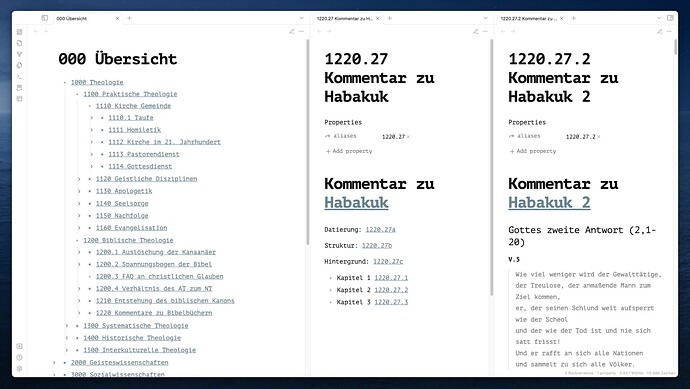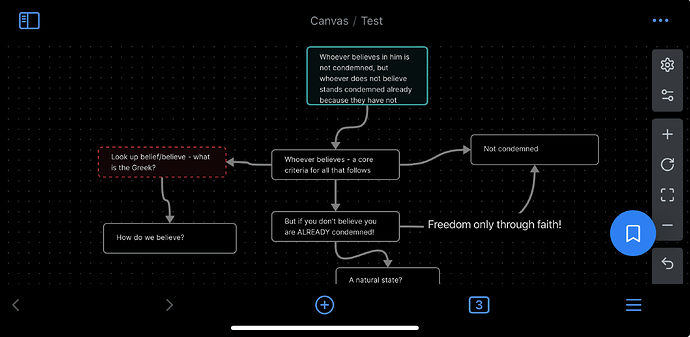Question especially for those of you who are using one file per chapter or one file per verse: is your Bible (and commentary) its own vault, or is this part of your main vault?
I have only one vault where everything is: My Bible (chapters per file), my daily notes and everything else.
Some reasons:
- I can link all files to a specific passage in the Bible.
- I can see which file links to which chapter (as backlinks).
- I can use the Bible Linker, which works perfectly for me.
Sorry for the delay in response, I think it may have been that the $book_file variable wasn’t being quoted properly. I made an update to the script to quote it on those 3 lines, you want to give it another try? bsb_to_obsidian.sh · GitHub
If that doesn’t work, then it could be that Linux doesn’t like the way I’m creating in the variable on line 28?
I am curious if anyone is familiar with Jonathan Edwards’ note-taking system and if there are any successful attempts with this system using Obsidian. Dr. Matthew Everhard has made numerous videos about Jonathan Edwards’ note-taking system:
Thank you for sharing! After watchting some of these videos, I decided to sort my notes according to the following system:
- T001, T002, T003 … for notes on theology
- I001, I002, I003 … for illustrations
… and some categories more. For each category I will create a list where I add new entrys manually.
I will also link the entries to the specific bible passage and I want to write it in the margin of my bible. In the margins of my bible i already have hashtags of special topics and smaler notes.
In this post I explain the structure of my Bible notes
I’m not sure I see the point of placing the whole Bible into Obsidian. The likelihood that anyone will have notes on every verse in their lifetime is highly unlikely. And you’re adding a huge amount of text into your vault.
Also, it is so easy to link to passages in Bible apps better suited for reading the text.
I insert only the passage I’m currently studying. This also reduces the noise in the vault and allows it to grow organically allowing me to see what I’ve actually studied.
I’m not using Edward’s system but build my own “Zettelkasten-like” system for note-taking including my Bible notes. I know that it’s very tedious and I’m not saying it’s for everyone. But I like that I have an unambiguous ID for every note that I can then reference in my print Bible.
Here is an example of my “Zettelkasten” vault (it’s a sub-vault within my main vault):
Anyone more experienced willing to do this for a number of Bible translations and then just share them? That way the rest of us (who know nothing of code) could use it! I’d be especially interested in a Greek (NA28) and Hebrew version.
Your system is very interesting. How do you deal with notes that refer to several Bible texts (e.g. “List of images for the church in the NT”)?
That sounds very good. I think the biggest problem with sharing Bibles like this is the copyright issue. If someone would do this work with copyright free versions (for the Greek Bible), I would be really happy (something like the Berean Study Bible GitHub - gapmiss/berean-study-bible-with-strongs: Markdown-based Berean Study Bible with Strongs Hebrew & Greek definitions, created for the Obsidian knowledge-base application.)
I use the BHS (Hebrew OT) and LXX (Greek OT) from this repo: GitHub - AnthropologieBiblique/MarkdownTexts: A collection of markdown texts for exegesis and theological research
I’m intermittently working on importing and formatting the SBLGNT for my vault. It has a pretty generous license: GitHub - LogosBible/SBLGNT: Source files for the SBL Greek New Testament.
For lists I just make a note with the relevant verses. Here are two examples, one with bible verses that speak on assurance of salvation and the other is just an ongoing list I just started with Paul’s prayers for the churches:
As you can see these too have their unique IDs so that they can be referenced in the vault and in my print bible. And then I just reference the note in my running commentary note.
In Public Domain is the Byzantine Text (NT) (GitHub - byztxt/byzantine-majority-text: Byzantine Majority Greek New Testament text edited by Robinson and Pierpont, with morphological parsing tags and Strong's numbers).
![]() nice solution
nice solution
I have something for SBLGNT and the MT, not really in shareable state unfortunately yet
I’m trying out Canvas as a means to map out Bible verses… really digging in deep, raising questions, visually seeing verses that correspond with each other (question/answer, for/against etc)
I’m experimenting with colour to highlight different types of card and relationships.
Not a real study:
I always wanted to get into biblearc.com but it seemed too time consuming and cost money. With obsidian I can embed notes and files right in the canvas if I think they’re relevant and even articles collated with Omnivore.
For me the best approach(but not perfect because of file system and obsidian limitations) is:
- One verse of the Bible = one note
- Text of each verse of the Bible is the TITLE of the note
a. Change all “:” to “⁚” symbol in title
b. Change all “?” to “‽” symbol in title - Using shorthand alias for each verse
- Content of each note is the crosslinks(cross references)
The 1-4 steps is for CORE notes
- For making grouping verses for example Genesis 1:1-2 we can use CORE notes within:
- The title is Genesis 1⁚1-2 with different symbol “⁚”, not “:”
- alias is Gen 1:1-2
- content is wiki links to CORE notes Gen 1:1 and Gen 1:2
You can see 5 verses of exodus 1
The mouse points to 2nd verse, and you can see popup window with cross reference to Jer 4:23
In the bottom you can see grouping of two verses as Gen 1:1-2
PROBLEMS: long verses are not supported by system(but in windows you can switch on to long names - more then 32000 symbols all path+naming of the file), but the Obsidian is not support long namings (it trunc the long title to default 255-260 symbols)
How did you import the text?
And why not use the Bible passage as the file name and the Bible text as the first line of the file?
You can also use the aliases with the text of the verse.
How did you import the text?
I don’t import all Bible, I just want to try how it feels after paste some verses by hand. If only all problems of this approach I could manage, so after I could do some script maybe.
And why not use the Bible passage as the file name and the Bible text as the first line of the file?
If I do this, then when forming a chapter I need to use the embed verses of notes itself.
Exodus 1
|title verse 1
|text of embed verse 1|title verse 2
|text of embed verse 2
…
And If I want to clean embed-style for perfect view I need to use some CSS snippets. Aliases not working on full in this approach I think. This approach is like swimming against the tide.
If I use my approach it is more simple to assemble the chapters with verses, no need for embed styling.
Exodus 1
[[verse 1]]
[[verse 2]]
…
I can use aliases of verses for linking in my texts in short way [[In the beginning God created the heavens and the earth.|Gen 1:1]], but can delete alias Gen 1:1 and I can see full verse in my text like [[In the beginning God created the heavens and the earth.]]
If I can assemble the chapters more easy, so I can make grouping parts of it like Gen 1:1-4 more easy with no embed style and use alias Gen 1:1-4.
And I can use cross references inside my verse notes in content part of the note.



